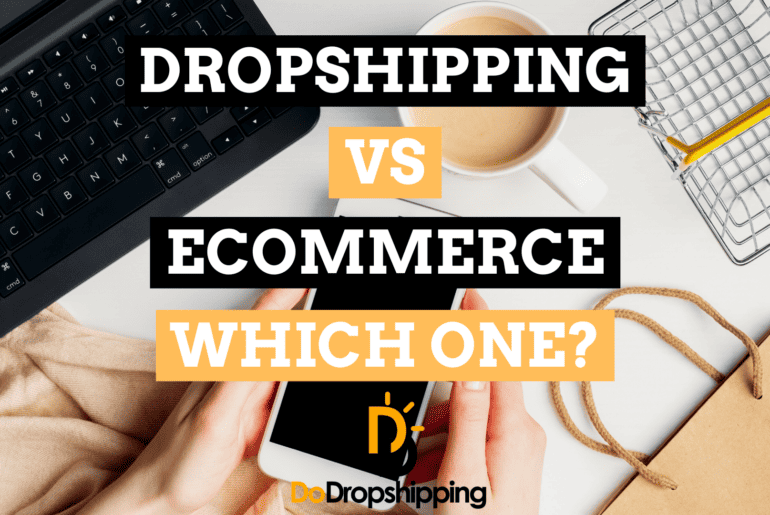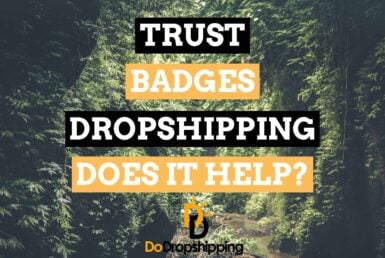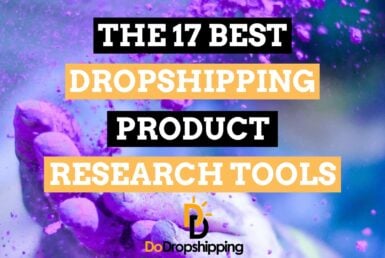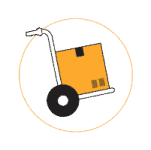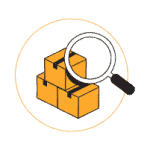Dropshipping and ecommerce are two of the most popular ways to start an online store.
Each can be a source of online income. However, they have several differences.
The main difference between dropshipping and ecommerce is that dropshipping involves selling products without keeping them in your inventory, while ecommerce is an all-encompassing term for all online commerce activities, including dropshipping, Amazon FBA, private labeling, and more.
So, a dropshipping store can be an ecommerce store, but an ecommerce store doesn’t necessarily have to be a dropshipping store.
The essence of this guide is to give you a deeper understanding of the differences and similarities between dropshipping and ecommerce.
So, keep on reading to learn more!
Dropshipping vs. ecommerce: An overview of the differences
Let’s get started with a handy overview of what's different between ecommerce and dropshipping:
| Ecommerce | Dropshipping |
| Ecommerce is all-encompassing and involves all online commerce activities. | Dropshipping is specific to selling products online that you don't have in stock. |
| An ecommerce storeowner handles inventory, shipping, customer service or support, and most other things related to running the business. | When dropshipping, you partner with a dropshipping supplier, who handles everything related to inventory, shipping, etc. |
| Ecommerce stores have more control over their brand, product quality, and customer experience. | Dropshipping stores have lesser control over these aspects of the business, mainly because they rely on dropshipping suppliers. |
| Ecommerce stores handle all fiscal responsibilities like taxes and financial reporting using in-house systems and tools. | Dropshipping stores have fewer fiscal responsibilities as they do not hold inventory. |
| An ecommerce store can also have a physical storefront or warehouse. | Most dropshipping stores do not have nor need a physical location to operate. |
| Ecommerce stores often invest more capital upfront to purchase inventory and pay for other business essentials like warehouses, fulfillment systems, etc. | Dropshipping allows for a lower initial investment because there is no need to purchase or manage inventory. |
| Ecommerce stores may have more wiggle room for higher profit margins. | Because of the massive competition in the dropshipping space, dropshipping stores may have lower profit margins. |
As the table above shows, there are vital differences between ecommerce and dropshipping.
In fact, it would be accurate to say that dropshipping and ecommerce are more different than they are alike.
Let’s now dive a bit deeper into both business models with a basic overview of each:
What is ecommerce?
Ecommerce is short for electronic commerce, which refers to selling products and services over the internet.
The top six ecommerce business models are:
- Dropshipping.
- Private labeling.
- Print on demand.
- Third-party fulfillment.
- In-house fulfillment.
- Drop servicing.
According to Statista, global retail ecommerce sales will hit $8.1. trillion in 2026!
Advantages and disadvantages of ecommerce
Like most other business models, ecommerce has advantages and disadvantages.
Let’s focus on them a little bit:
| Advantages | Disadvantages |
| Low overhead costs. Ecommerce saves you money on utilities because you can sell products online without a physical shop. | Shipping and handling. Ecommerce stores handle every aspect of the business. This can be time-consuming and costly. |
| Global reach. The internet allows ecommerce store owners to reach customers from all over the world. | Competition. Ecommerce is very competitive, with many well-established global players. This can make standing out difficult. |
| Data tracking and analysis. The best ecommerce platforms have built-in data analytics tools that allow you to track vital business metrics. | Customer service, complaints, and returns: Ecommerce business owners handle everything, which can be incredibly challenging and resource-consuming. |
| Quality control. Handling inventory in-house allows you to verify product quality and streamline the order fulfillment and delivery process. | Capital intensive. Investing in website development, marketing, product sourcing, warehousing, etc., can be capital-intensive. |
| Inventory control and management. Handling inventory in-house makes it easier to be on top of things. | Time-consuming. Depending on business size, ecommerce requires a substantial amount of time and resources. |
Let’s now focus on dropshipping:
What is dropshipping?
Dropshipping is an ecommerce fulfillment model where, as a dropshipping store owner, you do not physically stock the goods or handle the order fulfillment process.
Instead, dropshipping store owners transfer customer orders and shipment details to a dropshipping supplier who fulfills and ships the said order.
The dropshipping supplier could be a manufacturer, retailer, wholesaler, or dropshipping agent.
Related article: 91 Best Dropshipping Suppliers Worldwide in 2023 (Free & Paid)
When working with white or private label dropshipping suppliers, you can ask them to ship your products in branded packaging.
As a dropshipping business owner, your core role is to market your products, make sales, collect payments from customers, and then forward the orders to your dropshipping supplier, who will then fulfill and ship the order directly to the customer.
Below is a handy graphic showing how dropshipping works:
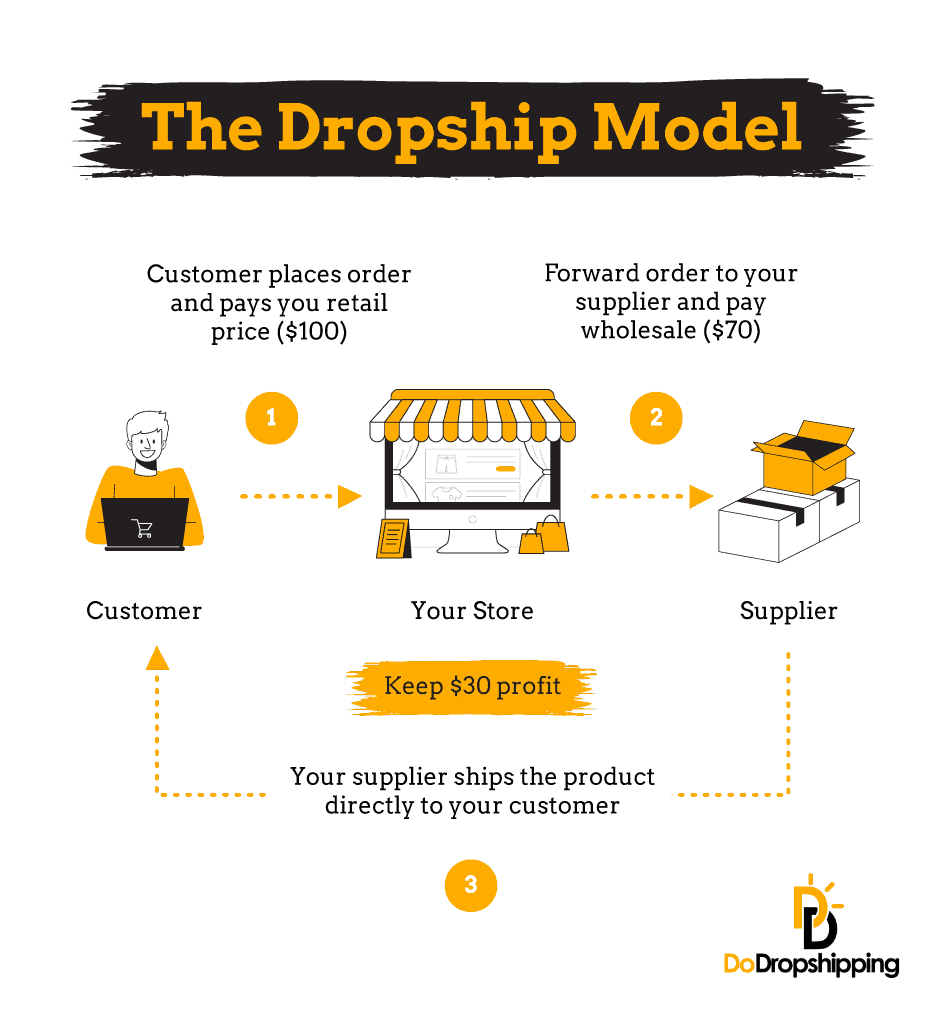
Advantages and disadvantages of dropshipping
Like ecommerce, dropshipping has advantages and disadvantages you should know:
| Advantages | Disadvantages |
| Low startup costs. Dropshipping has a low startup cost since many dropshipping suppliers have low minimum order quantity requirements, and you can start an online store with little capital. | Oversaturation. Because dropshipping has become very popular, niche markets can get saturated. That's why it's so important to do ample market research. |
| Dropshipping stores are easier to set up. Most dropshipping platforms and ecommerce marketplaces that support dropshipping have easy-to-use systems that make getting started easy. | Low-profit margins. Because dropshipping stores are a go-between between the customer and dropshipping supplier, your profit margins may be lower than with other ecommerce fulfillment models. |
| Saves time. Dropshipping stores outsource the entire inventory management, handling, and shipping process to a dropshipping supplier, thus saving time. | Difficulty building a brand. Building a solid dropshipping brand can be challenging when you only control some aspects of the business. |
| It's easier to experiment and scale. Since dropshipping has no inventory and inventory management, it's easier and cost-effective to experiment with your product volume to match growing demand. | Lack of quality and product control. Dropshipping store owners rely on a dropshipping supplier. This gives them reduced control over the product and brand quality. |
Now that we know what ecommerce and dropshipping are and each model's main pros and cons, let's move on.
As already mentioned, there are some apparent similarities between ecommerce and dropshipping.
Similarities between dropshipping and ecommerce
The standout similarities between dropshipping and ecommerce are:
- They are both online-based. Ecommerce and dropshipping businesses/stores operate from online stores.
- They both sell goods to customers. Both ecommerce and dropshipping involve selling products online. Take, for example, a dedicated clothes website that retails clothes they produce under their brand but also offers dropshipping services to resellers.
- Both have worldwide reach. An example of this could be a US-based ecommerce or dropshipping store that sources products from a China-based manufacturer. This store owner could hold some inventory for local order fulfillment while they have their dropshipping supplier fulfill all other orders.
- Both don’t require a physical storefront. In both cases, but especially with dropshipping, you do not need a physical storefront–with ecommerce, a physical store is optional.
Again:
Ecommerce and dropshipping are more dissimilar than they are alike. Let's focus on the main differences between the two business models:
Dropshipping vs. ecommerce: The key differences
Below are the primary dropshipping vs. ecommerce differences we have noted:
1. Inventory management
As discussed earlier, dropshipping stores have minimal inventory management needs because you, the dropshipping store owner, do not handle products physically.
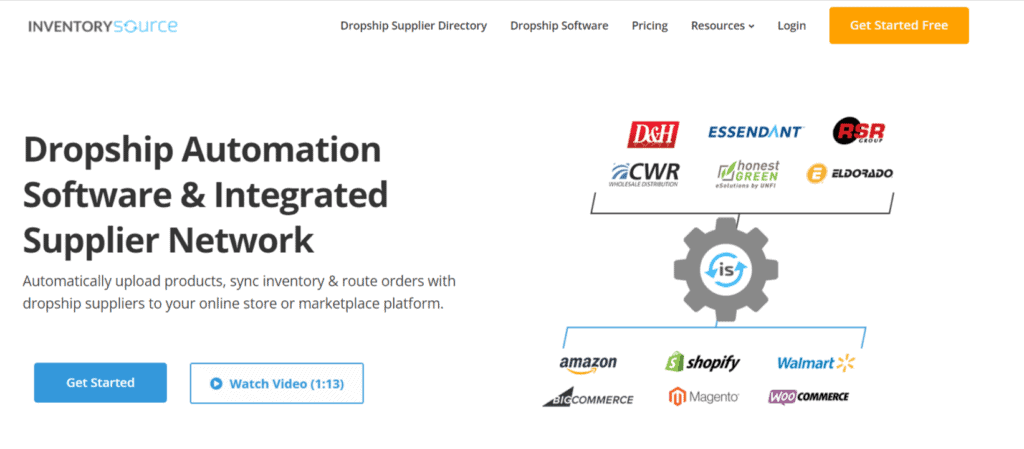
Your dropshipping supplier handles and ships the merchandise. Some suppliers can also brand the product and packaging at your request.
With ecommerce, you are responsible for purchasing and managing inventory, including product development–in some cases–fulfilling orders, shipping products to customers, restocking products, etc.
2. Product control
In dropshipping, you have limited control over the product quality because you do not directly handle the product in your day-to-day business life.
Instead, your dropshipping supplier handles everything related to the product, which gives you lower control over product quality.
On the other hand, with ecommerce, you have much more control over product quality because you have an in-house inventory sourcing and management system.
3. Capital investment
With ecommerce, you need more capital because you need to buy your products, either in bulk or wholesale, manage your stock and warehouse, fulfill and ship orders, and so much more, which all require capital.
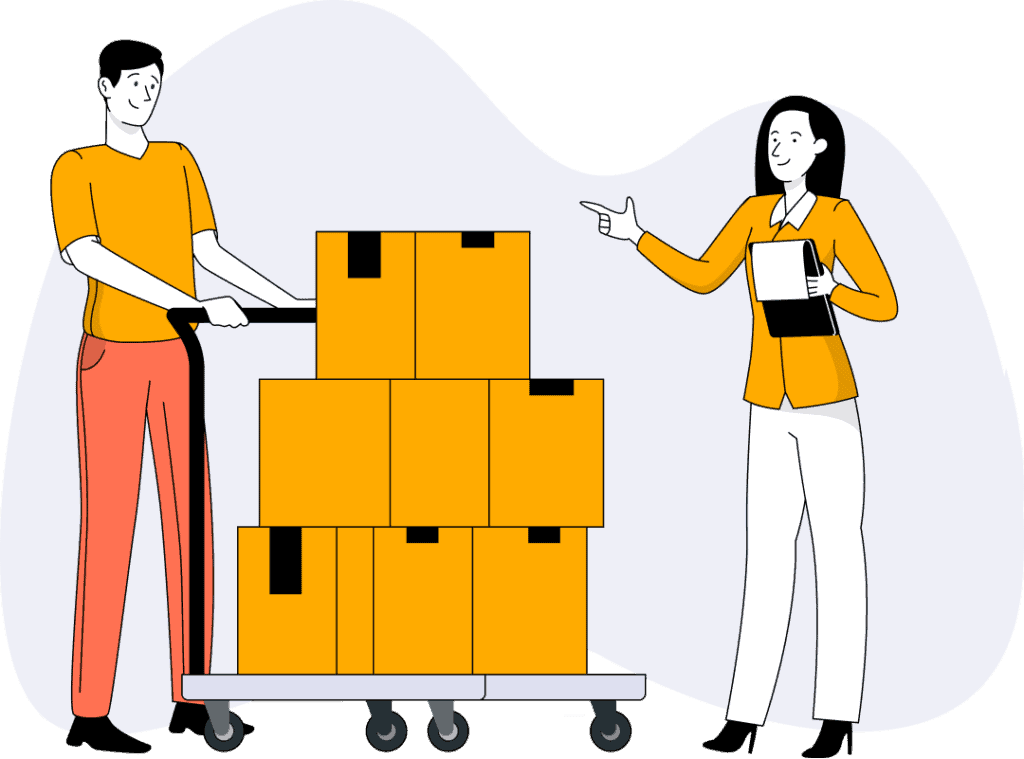
On the other hand, compared to a purely ecommerce store, a dropshipping store has lower capital requirements since you do not need to handle or manage stock–at least not in the traditional sense.
With dropshipping, you only need to handle the product periodically to check for quality.
Additionally, with ecommerce, you’ll have an in-house order fulfillment system that will require you to handle your products as you fulfill every order.
4. Profit margins
We’ve previously covered everything you would need to know about dropshipping profit margins.
Related article: Dropshipping Profit Margin: All the Stats You Need to Know
Fundamentally, dropshipping can have lower profit margins than conventional ecommerce and holding inventory because of supplier fees and because bulk buying often offers better product prices than on-the-fly purchases from a supplier.
This reduces the profit margins, especially in highly competitive niches and industries.
5. Time investment
As business owners, time is our most valuable resource. Thus, we need to use it well.

Dropshipping requires less time than ecommerce and holding inventory because your dropshipping supplier handles everything related to the product.
This includes storing and managing inventory, fulfilling and shipping orders, and, in some cases, customer service, including returns.
In comparison, ecommerce requires substantial time allocation to manage inventory, fulfill orders, and handle customer service.
6. Risk
The dropshipping fulfillment model is not as capital-intensive as other ecommerce models; thus, it is less risky because most of your upfront costs will go into building your store, ordering samples, and marketing campaigns.
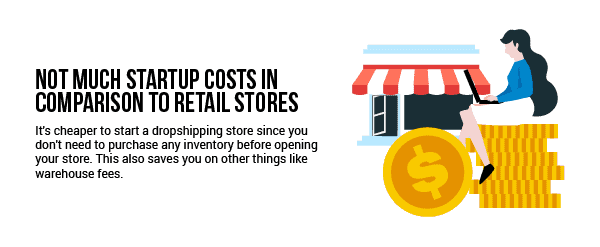
On the other hand, a purely ecommerce business is much more capital-intensive because your capital investment has to cater to inventory, setting up your ecommerce store, warehousing/inventory management, etc.
Thus, ecommerce is riskier than dropshipping, mainly because it’s not as easy to pivot and change products fast because of warehoused inventory.
7. Ecommerce is more than just selling products
Ecommerce includes services and other things–like SaaS–as well.
Some examples of ecommerce websites are auction and retail websites, online marketplaces, subscription-based services, and social media.
Any business that can conduct its business on the internet and sell products and services for profit can technically fall under the ambit of ecommerce.
In contrast, dropshipping is only about selling products from dropshipping/third-party suppliers.
8. Scope and scale
Ecommerce is much more scalable and covers a broader scope because it includes B2B, B2B2C, B2G, B2C, C2B, and C2C models.
In contrast, dropshipping is mainly B2C and C2C.
9. Data Analytics
Ecommerce metrics and data analytics are readily available because most ecommerce platforms have built-in tools that analyze the data.
Dropshipping data consolidation is not as easy to track and analyze, especially when working with multiple dropshipping suppliers or platforms, each using different analytic solutions.
Now:
One of the many things that make ecommerce so fascinating is that you can apply it in two primary ways: using models that require holding inventory and those that don't, like dropshipping, print on demand, and others.
Related article: How to Sell Products Online Without Inventory (4 Methods)
Let's talk a bit about holding inventory.
Dropshipping vs. holding inventory: Which model should you choose?
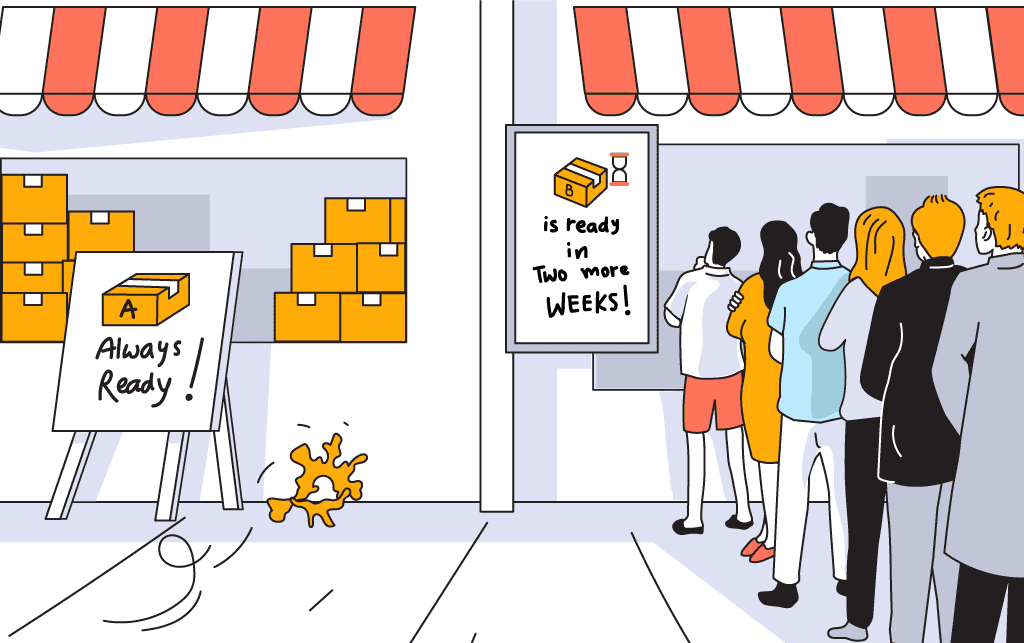
As we have discussed, dropshipping is an ecommerce fulfillment model where you do not hold physical inventory.
Instead, you conduct product research to find potentially profitable products you can list and sell in your dropshipping store.
As you market and sell your products, you forward individual orders to your dropshipping supplier or agent for fulfillment and shipping to your customers.
That is where dropshipping and holding inventory differ the most:
Dropshipping does not require an in-house inventory management system because you don’t handle inventory; your dropshipping supplier handles that part of the business for you.
On the other hand, when you hold some inventory, you need a working order fulfillment system that ensures customers get their orders.
Besides this:
Holding inventory has some advantages over dropshipping. For example, compared to dropshipping, holding inventory allows you to:
- Have more control over the fulfillment process. Holding products gives you more control over the order fulfillment process, making it easier to deliver orders quickly. For example, when Amer started holding inventory of his bestselling products, he could offer his UK & EU customers 2-day express shipping, which made a big difference.
- More control over pricing. Holding inventory often involves buying in bulk at wholesale prices. When you buy products at wholesale prices, you lower your cost per item, which can translate into more control over your pricing.
The most important thing to remember about dropshipping vs. holding inventory and which model you should choose is this:
| Dropshipping is great when: | Holding inventory is great when: |
| Dropshipping is great when you want to get started fast. This is because it does not involve handling or holding inventory. Thus, it has a lower startup cost. | Holding inventory is great when you want to take advantage of bulk buying at wholesale prices and have more control over order fulfillment locally. |
More importantly, remember that you can combine both.
For example, you can let your dropshipping supplier handle international shipping while you hold some inventory, fulfill, and ship local orders faster, like Amer.
Summary
Based on everything we have discussed, you can tell there are vital differences in how purely ecommerce and purely dropshipping stores operate and how dropshipping differs from holding inventory.
To recap, dropshipping, ecommerce, and holding inventory differ in the following key ways:
- Inventory management. Ecommerce store owners handle inventory in-house while dropshipping stores rely on dropshipping suppliers. When it comes to holding inventory, even dropshipping stores that also hold some inventory need an order fulfillment and management system.
- Profit margins. Because it often involves buying in bulk, ecommerce stores that hold inventory often have better profit margins than dropshipping stores.
- Time investment. Compared to ecommerce and holding inventory, dropshipping has a lower time investment.
- Risk. Because they require more upfront capital than dropshipping stores, holding inventory is riskier, primarily because of the chance of buying dead stock.
- Scope and scale. Unlike dropshipping, ecommerce stores have a broader scope because they can be B2B, B2B2C, B2G, B2C, C2B, or C2C, which increases their scalability. Likewise, holding inventory gives you a broader idea of how ecommerce businesses run. You can also scale your local fulfillment to meet growing demand.
- Data Analytics. The best ecommerce platforms have robust data analytics interfaces; in contrast, data analytics is not as easy with dropshipping, especially when you use multiple dropshipping suppliers.
Thus, depending on your store owner or business goals, choose a model that’s ideal for you.
The most important thing we want you to take away from this is that dropshipping is an ecommerce fulfillment model: a dropshipping store is an ecommerce store, but an ecommerce store does not necessarily have to be a dropshipping store.
If you take note of this crucial difference and the others we have discussed in this article, it should be easier to decide which of the two business models is ideal for you based on what you want to sell or your business goals.
Fundamentally:
| Choose ecommerce if | Choose dropshipping if | Choose to hold inventory if |
| You have enough startup capital. | You have little startup capital. | You have some money to invest in purchasing inventory. |
| You have some knowledge and experience running and managing an ecommerce store. | You are a beginner who wants to learn through experimenting. | You want to experiment with in-house order fulfillment. |
| You want to handle most aspects of your online store in-house. | You don’t want a fully hands-on store where you handle everything. | You have some bestselling products you would like to manage more. |
| You are willing to take on some risk if it means you will have complete control over your store. | You want minimal risk and don’t want to handle inventory or order fulfillment and shipping. | You are willing to bet on your bestselling products doing well in your target if you offer faster local fulfillment. |
Conclusion
There you have it: the core differences and similarities between dropshipping, ecommerce, and holding inventory.
We hope you learned something valuable from this article.
If you have any comments, thoughts, or questions, leave them in the comments section. We reply to all messages.
Otherwise, have a rocking day, and remember: keep learning, experimenting, and growing.
Want to learn more about dropshipping or ecommerce?
Do you want to learn more about either dropshipping or ecommerce?
If so, check out our dedicated dropshipping category or ecommerce category. Both are full of amazing articles like the three below:

